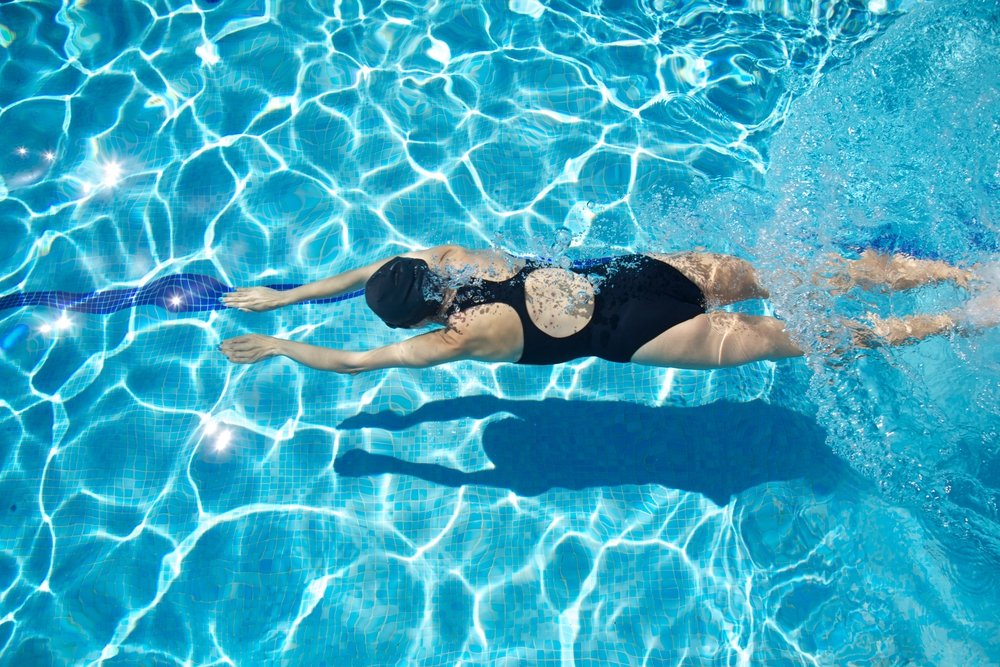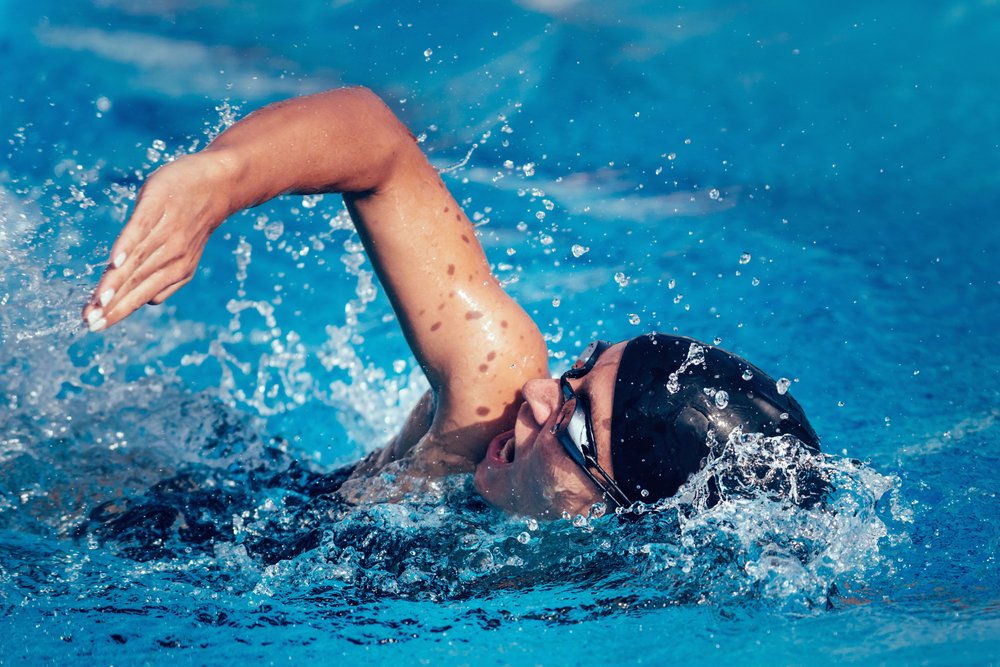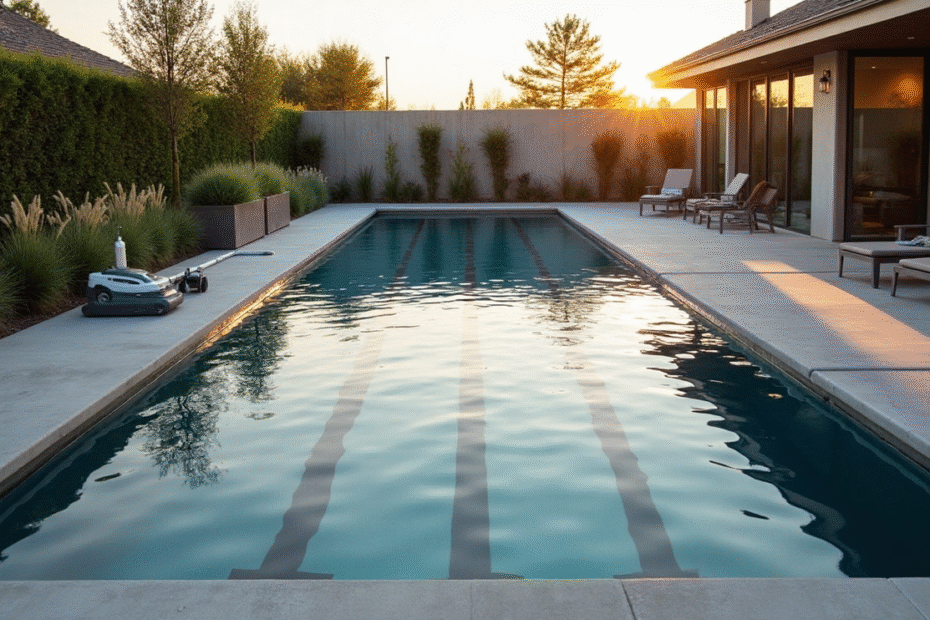Want a lap pool at home? I was amazed to find that these exercise pools cost between $44,000 and $50,000 on average. The price can reach $100,000 for your swimming sanctuary based on custom features and materials.
My research taught me valuable lessons about space requirements. A traditional lap swimming pool needs 40 to 70 feet in length. You’ll need 10 extra feet lengthwise and 6 feet widthwise just for clearance. I looked at swim-in-place pools as a space-saving option. These pools let you swim continuously without turning around. The ideal lap pool length should be at least 10 meters (about 33 feet) to enjoy your swimming routine.
Let me share my pool owner’s story with you. I learned so much while selecting, installing and maintaining my lap pool. My real-life experience taught me about different pool types and their actual costs. You’ll learn about the wins and challenges that came with my lap pool adventure.
Why I Chose a Lap Pool Over Other Options
My research into aquatic options ended up pointing me toward a traditional lap pool that best suited my needs. The choice wasn’t easy – I had to weigh several options before making this investment.
Comparing lap pools vs swim spas
Swim spas caught my eye right away when I started looking into home swimming options. These compact units blend pool and hot tub features. They measure 12-19 feet long, which is substantially smaller than traditional lap pools that stretch 40-75 feet.
The cost played a big role in my decision. Lap pools average around $44,000, while swim spas range from $20,000 to $60,000. The original price difference looked good, but the long-term math told a different story.
Space needs varied quite a bit between options. A lap pool demands extra room – about 10 more feet lengthwise and 6 more feet across. Swim spas need just 3 feet of clearance all around.
Swim spas shine with their year-round usability. Traditional pools often sit unused in cold weather, but swim spas come with heating systems and insulation that work in any climate. On top of that, swim spas filter their water every 15 minutes, while swimming pools take 12-18 hours.
My fitness goals and space limitations
My choice boiled down to what I wanted from my workouts. Swimming gives you three benefits at once – aerobic exercise, stretching, and strength training. Your core muscles stay engaged just by floating in the water.
Swimming appealed to me because it:
- Improves heart health and stamina
- Increases flexibility
- Helps manage weight
- Improves balance and cuts fall risk
- Boosts mental clarity and reduces stress
My yard had plenty of room for a full-length lap pool. This mattered a lot since I wanted to swim long distances without turning too often. Swim spas create resistance currents for swimming in place, but that experience didn’t feel right to me.
Why swim-in-place pools didn’t make the cut
Swim-in-place pools seemed like a perfect middle ground at first – smaller than lap pools but with similar exercise benefits. These systems use powerful jets or tether systems that let you swim in place.
After trying several models, the artificial current from swim jets didn’t give me the swimming experience I wanted. The strong jets create resistance that feels nothing like natural swimming. These systems work better for athletic swimmers, and I needed something my friends could use regardless of their skill level.
Tether systems cost less and had simpler mechanics, but felt too restrictive compared to regular swimming. The space savings couldn’t make up for feeling tied down during my workout.
Traditional lap swimming lined up better with my fitness goals and priorities, despite swim spas and swim-in-place options saving space and money. Sometimes the classic choice, even with its bigger footprint and cost, proves to be the perfect fit.

Understanding the True Lap Pool Cost
The cost of owning a lap pool goes way beyond the reach and influence of the original price tag. My research into pool costs revealed shocking expenses that weren’t listed in those glossy brochures. Here’s what I learned about the true investment needed to own a home lap pool.
Initial installation and permits
My start into pool ownership hit me with sticker shock – the average installation cost ranges from $40,000 to $65,000, though some homeowners spend as little as $6,000 or as much as $80,000. My 40-foot lap pool’s cost fell right in that average range.
Note that almost every municipality needs permits for pools deeper than 18-24 inches. This wasn’t just paperwork – I needed detailed site plans, project descriptions, and proof of property ownership. The permit cost me about $1,000, though prices vary by location. Some areas like New Orleans charge just $60, while other regions need extra fees for historic districts or special zoning.
The excavation process added another big expense. My lap pool’s digging and backfilling cost about $1,200, plus an extra $600 to haul away excess dirt. These “hidden” costs would have helped me budget better if I’d known about them earlier.
Ongoing maintenance and energy bills
The purchase price marked just the beginning of my financial commitment. My lap pool’s annual ownership cost runs between $4,000 and $12,000. This covers everything from chemicals to repairs.
My monthly maintenance costs average $80 to $150. I started with DIY maintenance at $50 per month for chemicals but switched to professionals at $100 monthly. This saved time and ensured better water chemistry.
The electricity costs hit hard. Most homeowners’ electric bills jump 30% to 50% after installing a pool. My monthly power costs to run the pump and occasional heating range from $65 to $100, changing with seasons. Pool homes use about 49% more electricity than homes without pools, which adds roughly $500 to annual costs.
The water bills grew too. My pool loses about ¼ inch of water daily through evaporation. Regular top-offs add $4 to $20 monthly to utility costs.
Unexpected expenses I didn’t plan for
These costs caught me off guard after installation:
- Insurance increases: My homeowner’s insurance cost rose $20 to $25 monthly due to more liability.
- Opening and closing services: Pool preparation costs $385 to $485 each spring and $365 to $650 each fall.
- Pool cover replacement: Quality covers cost from $500 for simple models to $3,000 for high-end options, and need replacement eventually.
- Filter maintenance: New filter media costs about $100 yearly, and pump repairs can exceed $800.
- Landscaping expenses: The pool area’s landscaping cost $4 to $12 per square foot.
The biggest concern involves potential structural issues. Leaks, cracks, and equipment failures pose major financial risks that initial budgets rarely include.
A dedicated “pool fund” for emergencies and routine maintenance helps avoid financial surprises. Good planning for these ongoing expenses makes lap pool ownership enjoyable rather than stressful.
Space and Design Considerations I Faced
Building a lap pool at home needs more than just a big backyard. You need smart design choices that balance how you’ll use it, how it looks, and what local rules allow. My experience with this project showed me some eye-opening facts.
How much space you really need
The actual space needed for a lap pool catches many homeowners off guard. Standard lap pools range from 30 to 40 feet long, though some can stretch to 75 feet. The width usually sits between 8 to 10 feet. My pool measures 8 feet across, which suits my solo swimming needs perfectly.
The pool itself isn’t your only space concern. You’ll need extra room around the edges too. Experts suggest 4 to 8 feet of deck space on every side. This extra area serves multiple purposes – it gives you walking space, keeps leaves and debris away from the water, and helps meet local safety requirements.
A modest 30-foot lap pool needs at least 38 feet long by 16 feet wide of space when you add the required deck area. My “perfect spot” needed much more room than I first thought.
Designing for both function and esthetics
My lap pool’s design focused on swimming functionality while creating an attractive backyard feature. The depth played a crucial role – I chose a consistent 1.2 meters (about 4 feet). This depth lets me swim comfortably without touching bottom but stays manageable for maintenance.
The entry points feature offset steps with a stainless steel grab rail rather than internal steps that would get in the way of swimming laps. This design keeps the swimming lane clear while offering safe and easy access.
The pool’s position takes advantage of natural sunlight and looks great from my home’s main living spaces. One pool expert told me, “You will spend more time enjoying the view of your pool while relaxing and entertaining than actually swimming in it”.
Dealing with zoning and property lines
Local rules turned out trickier than I predicted. Most areas require specific distances between pools and property lines – usually 5 feet from any lot line for properties 25 feet wide or more, or 3 feet from side lot lines on narrower lots.
This knowledge led me to do careful research before planning:
- I looked through my property’s title deed and survey plan
- I located all surveyor’s pegs and boundary markers
- I talked with my local building department about their requirements
My pool sits at the recommended 1 meter (approximately 3.3 feet) from property lines. Smart landscaping in this boundary area adds privacy and beauty to the overall design.
Installation Process: What Went Right and Wrong
My home lap pool construction taught me patience in ways I never expected. The experience from original planning to the first swim brought both triumphs and challenges.
Timeline from planning to completion
My lap pool installation took 12 weeks to complete, though contractors told me it usually takes 8-12 weeks. The project unfolded in these phases:
- Design and planning: 3 weeks
- Permit acquisition: 5 weeks (way longer than the 2-week estimate)
- Excavation: 3 days (no complications)
- Plumbing and electrical: 2 weeks
- Structure construction: 1 week
- Finishing work: 2 weeks
Bad weather added another week to my timeline – something no contractor had mentioned could happen.
Working with contractors and permits
Finding the right pool contractor was vital. I got quotes from three companies that showed big differences in pricing and features. I ended up choosing a contractor who had great reviews and solid experience.
The permit process turned out more complex than expected. My area’s permit process took over a month, while other places process them within days. My contractor handled most paperwork, but I still had to sign documents and show up for meetings.
We hit a major snag when the dig revealed bad soil conditions. Nobody had tested the soil properly beforehand. This mistake led to extra costs for soil compaction.
What I would do differently next time
Looking back, I should have focused on getting a full picture of the site before starting construction. The right soil testing would have saved me from surprise costs and delays.
The project needed a more detailed timeline with my contractor that included possible weather delays. I should have researched local rules myself instead of just trusting my contractor’s knowledge.
A clear communication plan with the contractor would have helped too. Not getting updates for weeks caused needless stress, especially when problems came up.

Daily Use and Maintenance Realities
My backyard swimming pool turned out to be more challenging than I expected. Life with a home lap pool has taught me valuable lessons about workout routines and maintenance requirements.
How often I use the pool for exercise
Swimming every day was my dream, but reality had other plans. Swim coaches say workout frequency makes a big difference in fitness results. One session per week won’t cut it, while three weekly sessions help maintain fitness without major improvements. Four sessions per week works best for me. This schedule lets me improve without pushing too hard.
My body tells me when to take it easy. A higher resting heart rate, muscle soreness, and unexpected afternoon naps signal the need to slow down. The pool still beckons on these days, but I focus on perfecting my technique instead of pushing hard.
Weekly maintenance tasks and tools
My lap pool needs 2-3 hours of care each week. The work includes several important tasks:
- Daily water level and circulation checks
- Weekly wall and step brushing
- Pool floor cleaning after brushing
- Water chemistry adjustments (pH 7.2-7.6, alkalinity 80-150 ppm)
- Debris removal from skimmer baskets
Quality maintenance tools make a huge difference in time and effort. You’ll need test kits, skimmer nets, telescopic poles, and brushes.
Energy efficiency and heating tips
A lap swimming pool uses 49% more electricity than homes without one. I’ve found ways to keep costs down:
- Water temperature stays at 78°F for swimming—every degree higher costs 10-30% more
- Pool covers cut evaporation by 30-60% and heating costs by 50-70%
- Filtration runs during cheaper hours (8 PM-10 AM)
- Timer settings limit filtration to one cycle daily
Good insulation helps keep the heat in. Wind can increase water evaporation by 300% or more, so I added windbreaks around my exercise pool.
Final Thoughts on My Lap Pool Experience
My home and fitness routine changed when I got a lap pool, though not exactly as I first imagined. This experience taught me that lap pools just need serious money—not just the $44,000 to $100,000 upfront cost, but also yearly maintenance runs between $4,000 to $12,000.
The space needed caught me off guard. My 40-foot lap pool needed extra room beyond its size. We had to plan carefully to fit it within our property lines and meet zoning rules.
Building the pool taught me a lot about patience and proper planning. What should have taken 8-12 weeks stretched to almost 12 weeks because of permit delays and unexpected issues. Anyone who wants to build a pool should add extra time to their plans.
Life with my lap pool is different from what I dreamed up. Instead of daily swims, I found a good rhythm with four sessions weekly that works well for fitness and recovery. The pool needs 2-3 hours of maintenance each week—it’s worth it, but it’s no small task.
Looking at everything now, my lap pool is still a great investment despite its challenges. Swimming whenever I want really helps my fitness routine and overall health. All the same, this choice works best if you have enough space, flexible money for ongoing costs, and really love swimming.
Would I do it again? Without doubt yes—but I’d be more realistic about timing, costs, and upkeep. My morning swims before work and evening relaxation boost my life quality. The investment pays off even with all the surprises along the way.
